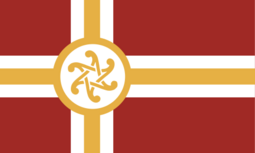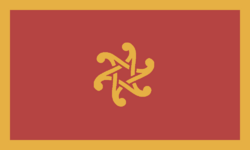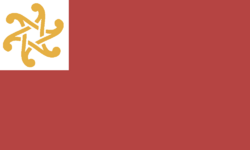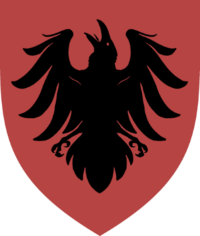Flag of Cuirpthe: Difference between revisions
No edit summary |
|||
| Line 21: | Line 21: | ||
The double triskelion symbol first appeared in 1832, on the naval jack and ensign of the Royal Navy. The symbol was derived from ancient pagan tradition, and had been a popular symbol of Cuirpthean nationalism during the Commonwealth and Midrasian periods. The symbol would be incorporated into the national flag following the collapse of the throne. The tricolor continued to be used as a symbol of the state, but also adopted as a symbol of the radical right (particularlym supporters of [[Maíreidh Unionism]]). In some cases, the radical left have also made use of the design, who repurposed the tricolor (with the addition of communist symbolism) for the flag of the [[Cuirpthean People's State]]. | The double triskelion symbol first appeared in 1832, on the naval jack and ensign of the Royal Navy. The symbol was derived from ancient pagan tradition, and had been a popular symbol of Cuirpthean nationalism during the Commonwealth and Midrasian periods. The symbol would be incorporated into the national flag following the collapse of the throne. The tricolor continued to be used as a symbol of the state, but also adopted as a symbol of the radical right (particularlym supporters of [[Maíreidh Unionism]]). In some cases, the radical left have also made use of the design, who repurposed the tricolor (with the addition of communist symbolism) for the flag of the [[Cuirpthean People's State]]. | ||
The current national flag is officially protected under the current Cuirpthean constitution from all acts of defamation and vandalism. Consequences of these acts, as defined by | The current national flag is officially protected under the current Cuirpthean constitution from all acts of defamation and vandalism. Consequences of these acts, as defined by the Cuirpthean ''Pioncód'', are fines and prison sentences of up to 5 years. | ||
==Origins== | ==Origins== | ||
| Line 31: | Line 31: | ||
{{further|List of Cuirpthean flags}} | {{further|List of Cuirpthean flags}} | ||
===Civil Flag=== | ===Civil Flag=== | ||
The Cuirpthean {{wpl|national flag}} was introduced in 1900, | The Cuirpthean {{wpl|national flag}} was introduced in 1900, following Cuirpthe's defeat in the Great War and subsequent reorganization by the Allied governments. In 1922, an amendment was made to the constitution that introduced new flags, including both military flags and a new {{wpl|civil flag}} and {{wpl|civil ensign}}. This flag is identical to the state flag, but only features the gold and white cross shifted to hoist, without the interlinked triskelions. This is the flag usually chosen to be flown by non-government authorities, and can be seen flying alongside most provincial flags. | ||
===Military flags=== | ===Military flags=== | ||
| Line 43: | Line 40: | ||
[[File:CuirptheNJ.png|thumb|right|250px|Cuirpthean naval jack]] | [[File:CuirptheNJ.png|thumb|right|250px|Cuirpthean naval jack]] | ||
The naval and civil ensign of Cuirpthe is flown on the stern of Cuirpthean ships when in port to denote nationality. It follows the design of the national flag, but removes the triskelion design in favor of a simple cross offset to the left. | The naval and civil ensign of Cuirpthe is flown on the stern of Cuirpthean ships when in port to denote nationality. It follows the design of the national flag, but removes the triskelion design in favor of a simple cross offset to the left, identical to the civil flag. | ||
[[File:CuirptheNE.png|thumb|right|250px|Cuirpthean civil and naval ensign]] | [[File:CuirptheNE.png|thumb|right|250px|Cuirpthean civil and naval ensign]] | ||
The naval and civil ensign of Cuirpthe is flown on the stern of Cuirpthean ships when in port to denote nationality. It follows the design of the national flag, but removes the triskelion design in favor of a simple cross offset to the left. The naval ensign would historically be flown at all times but in recent years, this has fallen out of practice. | The naval and civil ensign of Cuirpthe is flown on the stern of Cuirpthean ships when in port to denote nationality. It follows the design of the national flag, but removes the triskelion design in favor of a simple cross offset to the left. The naval ensign would historically be flown at all times but in recent years, this has fallen out of practice. | ||
Revision as of 23:31, 10 March 2020
 | |
| Use | State flag |
|---|---|
| Proportion | 3:5 |
| Adopted | 1900 |
| Design | A red field with a white and gold cross shifted to the hoist side. The cross is charged with interlocking golden triskelions. |
| File:CuirptheCivil.png Variant flag of Cuirpthe | |
| Use | Civil flag and ensign |
| Proportion | 3:5 |
| Adopted | 1922 |
| Design | A red field with a white and gold cross shifted to the hoist side. |
The flag of Cuirpthe (Cuirpthean: Bratach in Chuirpeidh) consists of a crimson field with a white and gold asymmetrical horizontal cross, with the crossbar closer to the hoist than the fly, with the cross extending to the edge of the flag. Where the cross intersects is a charge displaying two interlocking gold triskeles at the center of a gold circle. The flag was first adopted as the national flag of modern Cuirpthe in 1900, following the conclusion of the Great War.
Prior to the Great War, Cuirpthe had maintained a horizontal tricolor flag since the Kingdom of Cuirpthe's foundation in 1784. Red, white and gold were the colors of the 1712 revolution, one of several uprisings by the Cuirpthean people against the Commonwealth of Cuirpthe-Newrey during the Mydro-Commonwealth Wars. In 1722, a red, white and gold tricolor with the coat of arms of Midrasian Cuirpthe was adopted as the flag. In 1784, the coat of arms was removed to symbolize Cuirpthe's freedom from Midrasia.
The double triskelion symbol first appeared in 1832, on the naval jack and ensign of the Royal Navy. The symbol was derived from ancient pagan tradition, and had been a popular symbol of Cuirpthean nationalism during the Commonwealth and Midrasian periods. The symbol would be incorporated into the national flag following the collapse of the throne. The tricolor continued to be used as a symbol of the state, but also adopted as a symbol of the radical right (particularlym supporters of Maíreidh Unionism). In some cases, the radical left have also made use of the design, who repurposed the tricolor (with the addition of communist symbolism) for the flag of the Cuirpthean People's State.
The current national flag is officially protected under the current Cuirpthean constitution from all acts of defamation and vandalism. Consequences of these acts, as defined by the Cuirpthean Pioncód, are fines and prison sentences of up to 5 years.
Origins
The three colors of red, white and gold have been used as a symbol of Cuirpthean nationalism as early as the 18th century. During this period, when the Commonwealth was on the path of decline, rebellious movements had grown in Cuirpthe, and the three colors had seen widespread use on a tricolor flown in Ballinluska, Portlaoise and other major cities. Following the partition of the Commonwealth, the colors were officially adopted into the flag of Midrasian occupied Cuirpthe, and would remain as part of the Cuirpthean flag until the modern day.
The exact origins of the three colors is uncertain, and hotly debated among Cuirpthean scholars. While red has been part of Cuirpthean symbolism for centuries, dating back to the famous war banner of High King Fiachna, the addition of gold and red haven't been pinned down to a single source. One leading theory proposes that it has its origins in the symbol of the (tba) League, a revolutionary organization operating within Cuirpthe during the first half of the 18th century. Others have attributed the color scheme to the uniforms of the Free Cuirpthean Army (red with white trim), the military formed by rebels during the Mydro-Commonwealth Wars. However, this explanation fails to explain the inclusion of gold in the flag. Regardless of their origin, these colors are now recognized as the official colors of Cuirpthe, and were in some way incorporated into every subsequent flag of the nation.
Flag variants
Civil Flag
The Cuirpthean national flag was introduced in 1900, following Cuirpthe's defeat in the Great War and subsequent reorganization by the Allied governments. In 1922, an amendment was made to the constitution that introduced new flags, including both military flags and a new civil flag and civil ensign. This flag is identical to the state flag, but only features the gold and white cross shifted to hoist, without the interlinked triskelions. This is the flag usually chosen to be flown by non-government authorities, and can be seen flying alongside most provincial flags.
Military flags
The Cuirpthean military as a whole possesses no singular flag. The ground forces and naval branches of the military each make use of flags for the purpose of identification, though this practice is more maintained out of tradition.
The flag of the Cuirpthean Ground Forces is the Cuirpthean twin triskelion charged over a red field with a gold border around the edge of the flag. This was adopted in 1911 as the flag of the Cuirpthean Defense Army and readopted in 1936 when the CDA was reorganized into the Ground Forces. It's design is inspired by that of the naval jack of the Kingdom of Cuirpthe, which featured the same symbolism on a square flag.
The naval and civil ensign of Cuirpthe is flown on the stern of Cuirpthean ships when in port to denote nationality. It follows the design of the national flag, but removes the triskelion design in favor of a simple cross offset to the left, identical to the civil flag.
The naval and civil ensign of Cuirpthe is flown on the stern of Cuirpthean ships when in port to denote nationality. It follows the design of the national flag, but removes the triskelion design in favor of a simple cross offset to the left. The naval ensign would historically be flown at all times but in recent years, this has fallen out of practice.
The naval jack is a red field with a white square in the canton. The white square contains the Cuirpthean twin triskelion. This flag is flown at the highest point of military ships (historically, this was the mast of the ship), again for the purpose of denoting the vessel's nationality. The flag is loosely inspired by the naval ensign of the Kingdom of Cuirpthe, which was a tricolor possessing the triskelion in a black square at canton.
Design
Acticle 26 of the Cuirpthean Constitution states that The flag of the Republic shall be a cross in the colors of red, white and gold.
Following specifications laid out in the constitution, the flag displays a cross shifted to the hoist side. The vertical axis of the cross is exactly one-third of the way through the flag, and the horizontal axis at exactly halfway through. The circle and triskelion charge are centered at the intersection between the two axis of the cross.
The colors "red, white and gold" were not specifically defined at the time of the constitution's writing, but in 1978, the government released a flag code on the correct colors to use in production of the flags. The hexadecimal color codes for the three shades are B54442 (Red), E6B044 (Gold) and FFFFFF (White).



